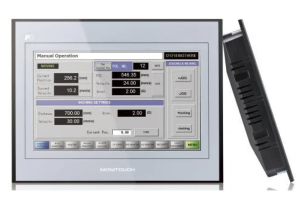
In today’s fast-paced, technology-driven world, Human-Machine Interface (HMI) screens have become indispensable tools in various industries. These interfaces are the primary point of interaction between humans and machines, enabling operators to control, monitor, and optimize processes with ease. This blog will delve into what HMI screen are, their significance in automation, and how they have revolutionized industries by enhancing efficiency and safety. We’ll also discuss their future potential and the trends shaping their development.
What is an HMI Screen?
An HMI screen, or Human-Machine Interface screen, is a device or software application that provides a visual interface for operators to interact with machines and processes. These screens are typically touch-sensitive and display real-time data, system statuses, and controls that allow operators to manage machinery or processes effectively. HMI screens are widely used in industries such as manufacturing, energy, transportation, and healthcare, among others.
The core purpose of an HMI screen is to simplify complex processes and present information in a user-friendly manner. Whether it’s a factory assembly line, a power plant, or a medical device, the HMI screen acts as the bridge between the human operator and the machinery, ensuring that everything runs smoothly.
The Role of HMI Screens in Automation
Automation has transformed the way industries operate, making processes faster, more efficient, and less prone to human error. At the heart of this transformation is the HMI screen. These screens play a critical role in automation by providing real-time feedback and control options to operators.
For example, in a manufacturing plant, an HMI screen might display the status of various machines on an assembly line, showing whether they are functioning correctly, if there are any errors, or if maintenance is needed. The operator can then use the HMI screen to make adjustments, troubleshoot problems, or even stop the production line if necessary.
In the energy sector, HMI screens are used to monitor and control power generation and distribution systems. They allow operators to keep track of energy output, detect faults, and ensure that the grid operates efficiently. This level of control and monitoring is crucial for maintaining stability and preventing blackouts.
Enhancing Safety with HMI Screen
One of the significant advantages of HMI screens is their ability to enhance safety in industrial environments. By providing real-time data and alerts, HMI screens enable operators to respond quickly to potential hazards. This is particularly important in industries like oil and gas, where even a small error can lead to catastrophic consequences.
HMI screens often come equipped with safety features such as emergency stop buttons, alarms, and automated shutdown procedures. These features help prevent accidents and ensure that operators can take swift action if something goes wrong. Moreover, the clear and intuitive design of HMI screens means that operators can quickly understand the situation and respond accordingly, even in high-pressure scenarios.
The Evolution of HMI Screen
Over the years, HMI screens have evolved significantly, both in terms of technology and usability. Early HMI screens were simple, monochrome displays with limited functionality. They provided basic information and required operators to input commands through physical buttons or switches.
Today, HMI screens are much more advanced, offering high-resolution, full-color displays with touch functionality. Modern HMI screens can integrate with other systems, such as Supervisory Control and Data Acquisition (SCADA) systems, to provide a more comprehensive view of operations. They can also display complex data visualizations, making it easier for operators to interpret information and make informed decisions.
In addition to improved display technology, HMI screens have become more user-friendly. With the rise of smartphones and tablets, users have become accustomed to intuitive touch interfaces, and HMI screens have followed suit. This shift towards more accessible, user-centric design has made HMI screens easier to use, reducing training time and increasing efficiency.
Future Trends in HMI Screen
As technology continues to advance, the future of HMI screens looks promising. One of the key trends shaping the development of HMI screens is the integration of the Internet of Things (IoT). By connecting HMI screens to IoT devices, operators can access even more data and gain deeper insights into the performance of machinery and processes.
Another trend is the use of augmented reality (AR) and virtual reality (VR) in HMI screens. These technologies have the potential to revolutionize the way operators interact with machines, providing immersive, 3D visualizations that make complex processes easier to understand. For example, an operator could use an AR-enabled HMI screen to visualize the inner workings of a machine and identify potential issues before they become serious problems.
Artificial intelligence (AI) is also set to play a significant role in the future of HMI screens. By incorporating AI, HMI screens can become more predictive, offering suggestions and automating routine tasks. This could further reduce the need for human intervention, allowing operators to focus on more strategic activities.
Customization and Scalability of HMI Screen
Another significant advantage of modern HMI screens is their ability to be customized and scaled to meet the specific needs of different industries and applications. For example, in a factory setting, the HMI screen can be tailored to display only the most relevant information to the operator, reducing clutter and minimizing the risk of error.
Scalability is also an important consideration, especially in large operations. HMI screens can be configured to work seamlessly across multiple machines or locations, providing a unified interface that operators can use to monitor and control various aspects of the operation. This flexibility makes HMI screens an essential tool for businesses looking to streamline their processes and improve overall efficiency.
Conclusion
HMI screen have come a long way from their early beginnings as simple display panels. Today, they are sophisticated, user-friendly interfaces that play a critical role in the automation and optimization of industrial processes. By providing real-time data, enhancing safety, and enabling greater control over machinery, HMI screens have become indispensable tools in a wide range of industries.


